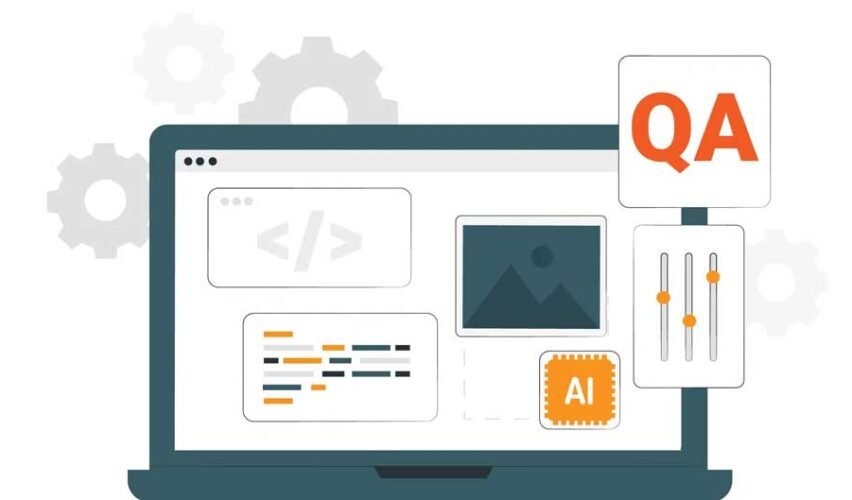In the fast-paced world of software development, Quality Assurance (QA) has become more crucial and complex. As teams aim to deliver smooth digital experiences quicker than ever, traditional testing methods are finding it hard to deliver software quickly with more accuracy and scalability.
This is where AI in testing enters, carrying a fresh wave of innovation, transforming the entire QA process entirely. Using intelligent test orchestration powered by AI doesn’t just boost test efficiency; it also lets teams develop amazing, high-quality software. From predicting defects to automatically creating and running tests, AI is totally changing how software testing is done.
This blog talks about the role of AI in testing, mainly with intelligent test orchestration. We will dig into what intelligent test orchestration actually means, how AI makes QA better, benefits, challenges and what’s ahead for AI-driven testing.
Understanding the Need for Intelligent Test Orchestration
First, we have to grasp the issues that conventional testing techniques bring in order to appreciate the relevance of AI in this field. Manual testing lacks scalability, is labor-intensive, and is prone to human error. Though faster than manual testing, even automated testing depends mostly on predefined scripts and requires ongoing maintenance.
Test orchestration is the coordinated implementation of tests over several environments, tools, and pipelines. QA teams manually create test workflows, decide test priorities, distribute resources, and analyze outcomes in traditional test orchestration. This process is both labor-intensive and challenging to maximize.
Conversely, intelligent test orchestration manages and maximizes these test processes independently using AI and Machine Learning (ML). It lets testing become more adaptive, predictive, and perceptive. It’s about making wiser decisions on what, when, and how to test, not only about accelerating tests.
What is AI in Testing?
AI in testing means applying Artificial Intelligence and Machine Learning algorithms to automate and enhance testing capabilities across many elements of the software testing lifecycle. Furthermore, these advanced technologies can allow systems to learn from past data, detect patterns, predict future bugs, and ultimately make decisions and perform actions through minimal human interaction.
AI can be used in several elements of testing, including:
- Test case creation
- Test execution
- Defect prediction
- Test data management
- Root cause analysis
- Test maintenance
AI in software testing speeds up the whole process, reduces errors and makes tests run much smoother. This is important in our fast-moving world of Agile, DevOps, and automation, where speed is key.
How AI is Revolutionizing QA Through Intelligent Test Orchestration
Let’s explore how AI-driven intelligent test orchestration is revolutionizing quality assurance.
Automated Test Case Generation and Optimization
Creating and maintaining test cases is one of the most labor-intensive tasks of QA. AI helps testers analyze application workflows, historical test data, and code changes automatically to create test cases, and even optimize existing test suites by removing duplicates or old tests and prioritizing tests based on functional coverage and risk.
As a result, this reduces testing time, enhances the coverage of test cases, and increases the chance of finding defects early in the process.
Risk-Based Test Prioritization
AI helps focus your team’s testing effort on the right areas by prioritizing tests based on risk.
This strategy reduces testing time and improves speed and accuracy while ensuring that any critical features are tested thoroughly.
Smart Test Execution Scheduling
AI algorithms can dynamically schedule tests based on resource availability, test dependencies, execution history, and system load. This is particularly beneficial in large-scale CI/CD pipelines where tests must be run in parallel and periodically to avoid delays.
Smart scheduling assists in minimizing the test execution time while maximizing the use of resources.
To fully realize these benefits, leveraging the right platform is key.
KaneAI is a GenAI-native testing assistant developed by LambdaTest to transform the way software tests are written, managed, and debugged. It allows testers, developers, and even non-technical users to create and evolve automated test cases using plain English prompts.
Whether you’re working on web or mobile, KaneAI can automatically generate test scripts, suggest corrections, and provide intelligent debugging support—all without needing you to manually code from scratch.
Predictive Defect Analysis
AI can analyze historical test results and historical development data and predict where defects are likely to show up. These predictions help testers decide which modules are associated with a higher risk of bugs so that testers can prevent a potential failure before it reaches production.
By catching defects early in the life cycle, teams can save time and fix the issue earlier so that the bugs don’t reach the final stage of production.
Intelligent Test Data Management
AI tools can examine data requirements and automatically prepare, mask or select the correct data sets for testing. The amount of time saved for QA teams from intelligent test data management can be a huge time saver while allowing a consistent and valid test environment.
Furthermore, intelligent test data management meets new data protection compliance challenges, like GDPR, by never needing to use real user data that may be sensitive.
Adaptive Test Maintenance
Test scripts tend to break when the application UI changes. The use of AI in testing allows for test scripts to automatically adapt to accommodate minor changes to the UI with no manual interaction.
For instance, if a button label changed from “Submit” to “Send,” AI would recognize this and only change the label without stopping the test.
The ability to adapt is highly favorable in that it significantly reduces test maintenance overhead, which is a common issue with test automation.
Improved Reporting and Insights
With AI smart capabilities, test orchestration platforms can provide intelligent dashboards that visualize testing metrics to clearly show patterns, trends and defects. Such insights can provide meaning to the data allowing QA and development teams to make smart decisions, identify root causes of issues, and improve their processes over time.
Benefits of AI-Driven Intelligent Test Orchestration
AI in testing and intelligent test orchestration comes with numerous strategic benefits:
Faster Time to Market
AI automates and facilitates many different types of testing, which allows for releases to happen faster without losing quality. Teams can feel confident in updating their software and app features in shortened release cycles.
Increased Test Coverage
AI uses large datasets and analyzes user behavior, meaning it will know the most important areas need to be tested and this ensures better overall coverage
Cost Savings
AI saves huge amounts of money for teams by catching issues earlier and emphasizing accurate workflows and efficient test case execution.
Improved Accuracy
With AI testing, the risk of human error is eliminated. The AI executes tests consistently and analyzes data consistently, with decision-making based on facts and evidence. This leads to more accurate outcomes.
Continuous Learning and Improvement
Whereas a manual testing performs a limited range of test cases, an AI system learns as it performs more tests. As the AI analyzes the data, the AI becomes smarter and potentially more accurate in decision-making.
Challenges and Considerations
Inevitably, however, AI in testing has significant challenges that organizations must address:
Data Quality and Availability
AI systems are only as good as the data they use; if the data is bad or inconsistent, then the AI is not going to be very good at testing. Bad or insufficient data can make AI ineffective in testing.
Integration Complexity
Integrating AI tools with existing test and QA infrastructure, CI/CD pipelines, test environments, and workflows can be difficult and may require changing an organization’s processes and architectural design.
Skills Gap
We have seen a significant gap of skilled QA professionals with AI and Machine Learning expertise. QA professionals must be trained or upskilled to take full advantage of AI testing.
Best Practices for Implementing AI in Testing
As you consider how to implement AI in testing and intelligent test orchestration, here are some best practices to follow.
Start small and scale
Begin with a simple project that targets a specific area—perhaps test case prioritization or defect prediction. Make a record of your results, gather feedback, and scale your implementation accordingly.
Engage different teams
Bring in developers, QA professionals, data scientists, and product managers to bring common understanding between them.
Carefully select your tools
Use AI-powered testing tools that easily integrate with your existing workflow and make it easier to achieve your goals.
Focus on data strategy
Having clean, relevant data and labeled data will help you train your AI models. Update data regularly and develop capabilities to continuously improve the models based on results.
Monitor and Audit AI decisions
Continuously monitor the performance of any AI-based process and verify the decisions made, even when tools are delivering accurately. Build processes that enable human oversight at critical points
The Future of AI in Testing
AI in testing is still relatively new, but it’s clear where it’s heading. As the capability of AI technologies ultimately increases, QA practices will also become more advanced and autonomous.
Here are some emerging trends:
- Self-healing tests that can adapt immediately without human intervention as the application changes.
- AI copilots to testers that can either suggest or automate new scripts based on requirements.
- Hyperautomation in QA, where end-to-end testing is fully automated via AI.
- Natural language testing where testers can describe what they want in plain English and AI does the rest.
- Explainable AI, which gives insight into how AI is making testing decisions.
As these advances further develop, QA will become a more strategic role, not simply finding bugs, but providing an outstanding user experience through intelligent automation.
Conclusion
The use of AI in testing or intelligent test orchestration is not a temporary trend—it’s a revolution that is changing how we all think about QA. AI gives organizations the workflows they need to confidently keep pace with the demands of software development in today’s world while offering speed, intelligence and accuracy.
If you are a tester, developer, manager, or decision-maker, now is the time to get on board to transform your reality. The future of QA is about using the capabilities provided by AI—not just the automation of tests but elevating it to new heights.
Investing in AI for software testing is not just about keeping up with the competition; it’s about staying ahead and delivering the kind of digital experiences your users expect and deserve.



